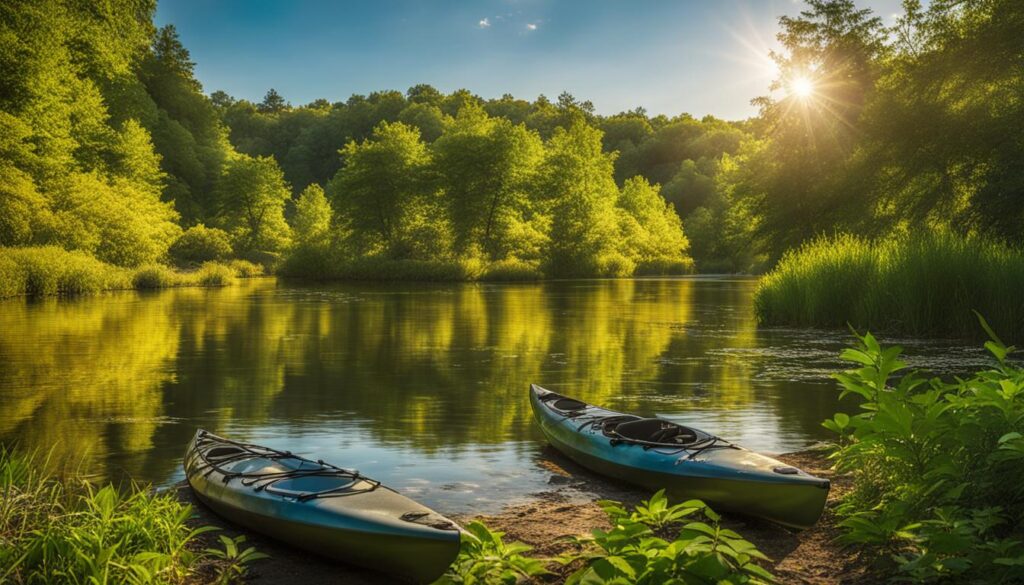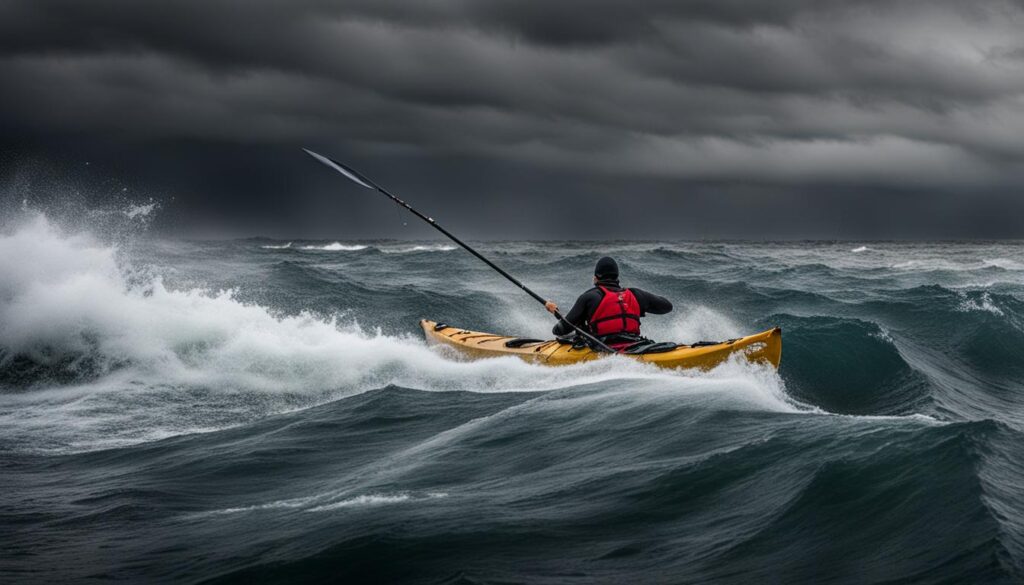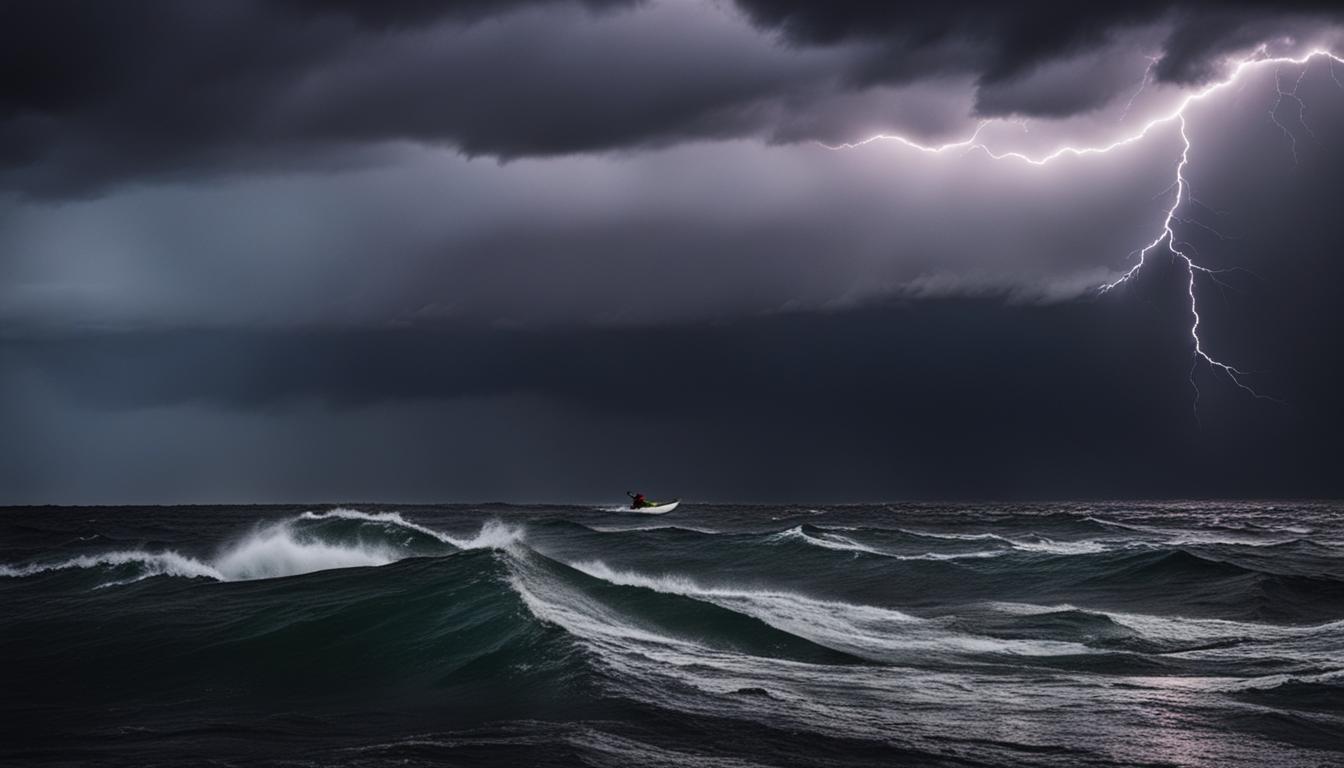When it comes to kayak fishing, understanding and adapting to different weather conditions is crucial for success. The temperature, water flow rate, wind, and water clarity all play a significant role in determining the best strategies for a successful fishing trip. By considering these weather factors and making the necessary adjustments, you can improve your chances of a productive outing.
Key Takeaways
- Take into account the temperature, water flow rate, wind, and water clarity when planning a kayak fishing trip.
- Consider the 120-degree Fahrenheit rule for an ideal kayaking experience.
- Understanding water flow rates is essential, especially in rivers and streams.
- Navigate windy conditions by positioning yourself with the back to the wind.
- Murky water can provide advantages for fishing, such as closer approaches and successful bait presentations.
The Impact of Temperature on Kayak Fishing
Temperature plays a crucial role in determining the success of your kayak fishing trip. Both air and water temperature should be taken into account to ensure optimal conditions. The ideal temperature for kayaking is when the sum of the air and water temperature equals 120 degrees Fahrenheit. This provides a comfortable and enjoyable experience on the water. However, fishing in extremely hot weather can lead to discomfort and reduced fish activity, while fishing in extremely cold weather can pose risks of hypothermia.
In general, spring and autumn are considered good times for kayak fishing, as water temperatures reach the ideal range of 60 degrees or above. During these seasons, fish are more active and feeding, increasing your chances of a successful catch. It’s important to monitor the temperature and plan your fishing trips accordingly to optimize your chances of success.
Remember to dress appropriately for the weather conditions. In cold weather, wear layers of warm, windproof, and waterproof clothing to stay comfortable and prevent hypothermia. In hot weather, ensure you stay hydrated and wear lightweight, breathable clothing to stay cool. By adapting to the temperature and understanding its impact on fishing conditions, you can increase your chances of a productive and enjoyable kayak fishing experience.

Table: Ideal Temperature Ranges for Kayak Fishing
| Season | Ideal Water Temperature (°F) |
|---|---|
| Spring | 60-70 |
| Summer | 70-80 |
| Fall | 60-70 |
| Winter | 50 and below |
Understanding Water Flow Rates
When kayak fishing in rivers and streams, it’s important to have a good understanding of water flow rates and how they can impact your fishing experience. The speed at which the water is flowing can greatly affect your ability to stay still and control your kayak. It is crucial to monitor the water flow rate before heading out and adjust your fishing strategy accordingly.
Water flow rates are typically measured in cubic feet per second or minute, but what matters most for fishing purposes is the speed. If the water is flowing faster than 5 miles per hour, it can be challenging to maintain stability and control in your kayak. In such instances, anchoring or using a drift sock can help you stay in place without being swept away by the current.
It’s also important to consider how water flow rates can impact fish behavior. In faster-moving water, fish tend to congregate in areas where they can conserve energy, such as behind rocks or in eddies. By understanding these patterns, you can focus your efforts on areas where fish are more likely to be present.
| Water Flow Rate | Fishing Strategy |
|---|---|
| Slow Flow (less than 2 mph) | Focus on slower-moving pools or slackwater areas with steady presentations |
| Moderate Flow (2-4 mph) | Target riffles, runs, and areas with structure where fish may be actively feeding |
| Fast Flow (more than 4 mph) | Look for eddies, backwaters, and areas with slower current where fish seek refuge |
By understanding water flow rates and adjusting your fishing strategy accordingly, you can enhance your chances of success when kayak fishing in rivers and streams. Pay attention to the current speed, adapt your approach, and focus on areas where fish are likely to be located. Remember, patience and persistence are key when fishing in moving water.
Navigating Windy Conditions
When it comes to kayak fishing, dealing with windy conditions can be challenging, but with the right techniques, it is possible to navigate and even use the wind to your advantage. Strong winds can make it difficult to maintain stability and control in a kayak, but by positioning yourself with the back to the wind, you can harness its power and use it as a natural trolling motor to propel your kayak.
To minimize the impact of the wind on your fishing, it’s important to make periodic adjustments. Keep your rod and line low to the water to reduce wind resistance and maintain control over your bait. By utilizing these techniques, you can overcome the challenges posed by windy conditions and continue to enjoy a productive fishing experience.
Remember that safety should always be a top priority, especially in windy conditions. Make sure to wear a personal flotation device (PFD) and be aware of your surroundings. Respect the power of the wind and avoid venturing too far from shore if the conditions are particularly challenging. By practicing caution and utilizing the wind to your advantage, you can have a successful kayak fishing trip even on windy days.
“Positioning yourself with the back to the wind allows you to use it as a natural trolling motor, propelling your kayak.”
Table: Tips for Kayak Fishing in Windy Conditions
| Tip | Description |
|---|---|
| Position with the Back to the Wind | Use the wind as a natural trolling motor by facing against it. |
| Make Periodic Adjustments | Keep your rod and line low to minimize wind resistance. |
| Wear a Personal Flotation Device (PFD) | Ensure safety by wearing a PFD in case of any unexpected circumstances. |
| Respect the Power of the Wind | Be cautious and avoid venturing too far from shore in challenging conditions. |

Making the Most of Murky Water
When it comes to kayak fishing, clear water is often considered ideal. However, fishing in murky water can also have its advantages. While visibility may be reduced, this can actually work to your advantage as it makes it harder for fish to spot your presence. The reduced clarity allows for closer approaches and more successful bait presentations, increasing your chances of a successful catch.
When fishing in murky water, it’s important to adapt your strategies accordingly. Consider using lures or baits that create vibrations or make noise to attract fish. Fish that rely heavily on their sense of hearing and vibration detection may be more responsive to these types of lures in murky water. Additionally, you may want to experiment with using scented baits to enhance their attractiveness in low visibility conditions.
Another advantage of fishing in murky water is that it can often be less crowded. Many anglers prefer clear water, so fishing in murky conditions may give you the opportunity to have a relatively undisturbed fishing experience. Take advantage of this by exploring areas that are less frequented and targeting fish that may be less wary due to the reduced fishing pressure.
“Fishing in murky water can be a rewarding experience, despite the challenges it may present. By adapting your strategies and taking advantage of the reduced visibility, you can increase your chances of a successful kayak fishing trip.”
Remember to remain patient and observant when fishing in murky water. Pay close attention to any signs of fish activity, such as ripples, splashes, or birds diving into the water. These indicators can help guide you to areas where fish may be actively feeding. Overall, don’t let the murkiness deter you from exploring new fishing opportunities and enjoying the adventure of kayak fishing in less than ideal conditions.
| Advantages of Fishing in Murky Water |
|---|
| Reduced visibility makes it harder for fish to spot your presence. |
| Allows for closer approaches and more successful bait presentations. |
| Less crowded fishing conditions, with potentially less fishing pressure. |
| Opportunity to explore and target fish in undisturbed areas. |
Kayak Fishing in Adverse Weather
When it comes to kayak fishing, adverse weather conditions should not deter you from heading out on the water. With the right preparation and fishing tactics, you can still have a great day of fishing, even in rough conditions. Here are some tips to help you navigate adverse weather and increase your chances of a successful kayak fishing trip:
1. Be Prepared with the Right Gear
Before heading out, make sure you have the necessary gear to stay safe and comfortable in adverse weather. Wear a quality personal flotation device (PFD) to ensure your safety, especially in case of unexpected capsizing. Dress appropriately for the conditions, layering up with warm, windproof, and waterproof clothing to protect yourself from the elements. Don’t forget to bring a survival/first aid kit and a waterproof bag to keep your belongings dry.
2. Adjust Your Fishing Techniques
Rough weather conditions can affect fish behavior and their feeding patterns. During windy or rainy weather, fish tend to seek shelter and stay closer to the bottom. Adjust your fishing techniques accordingly by using heavier baits or lures to reach the deeper areas where fish may be hiding. Slow down your retrieval speed and focus on presenting your bait near structures or in calmer areas for better chances of enticing bites.
3. Stay Mindful of Safety
In adverse weather, safety should always be your top priority. Be aware of changing weather conditions and always check the forecast before heading out. Avoid kayaking in thunderstorms, strong currents, or extremely high winds. If you encounter challenging conditions while on the water, stay calm and paddle towards the nearest shore or a protected area. Remember to maintain good communication with someone on land and let them know your float plan and expected return time.
Remember, even in adverse weather, kayak fishing can still be an enjoyable and rewarding experience. By being prepared with the right gear, adjusting your fishing techniques, and prioritizing safety, you can overcome the challenges and make the most out of your kayak fishing adventures.
Table:
| Adverse Weather Fishing Tips | Benefits |
|---|---|
| Dress in warm, windproof, and waterproof clothing | Protection from the elements |
| Use heavier baits or lures | Reach deeper areas where fish may be hiding |
| Stay updated with weather forecasts | Avoid unfavorable conditions |
Winter Kayak Fishing Tips
When it comes to kayak fishing in the winter, preparation is key. The cold weather presents unique challenges that can be overcome with the right gear and techniques. Here are some essential tips to help you enjoy a successful and safe kayak fishing experience during the colder months:
- Dress appropriately: Layering is crucial when facing low temperatures. Wear moisture-wicking base layers to keep your body dry and insulated, followed by warm and windproof clothing. Don’t forget to protect your extremities with insulated boots, waterproof gloves, and socks.
- Ensure safety: Safety should always be a priority. Wear a quality personal flotation device (PFD) to stay buoyant in case of accidental immersion. Prepare a float plan and let someone know your intended route and estimated return time. Carry a survival/first aid kit in case of emergencies.
- Adapt your techniques: In cold weather, fish tend to move slower and seek deeper holes for warmth. Downsizing your lures and using slower presentations can increase your chances of attracting bites. Pay attention to the water temperature and adjust your fishing spots accordingly.
- Stay informed about the weather: Keep an eye on weather forecasts, paying attention to wind speed and direction. Strong winds can make kayaking more challenging, so choose sheltered areas and plan your fishing trips accordingly. Be prepared for sudden weather changes and know when to call it a day if conditions become unsafe.
By following these winter kayak fishing tips, you can enjoy the beauty of fishing in colder months while staying safe and comfortable on the water. Remember to dress appropriately, prioritize safety, adapt your techniques, and stay informed about the weather. With the right preparations, you can have a successful and enjoyable winter kayak fishing adventure.
| Winter Kayak Fishing Tips |
|---|
| Dress appropriately |
| Ensure safety |
| Adapt your techniques |
| Stay informed about the weather |
Remember, the key to winter kayak fishing is being prepared and taking the necessary precautions. It’s important to dress in layers, prioritize safety, adapt your techniques, and stay informed about the weather conditions. With these winter kayak fishing tips in mind, you’ll be ready to tackle the cold weather and enjoy your fishing adventures throughout the winter season.
Conclusion
Adapting to different weather conditions is crucial for successful kayak fishing. By considering factors such as temperature, water flow rate, wind, and water clarity, you can make informed decisions and adjust your strategies accordingly. Understanding the impact of weather on fishing can improve catch rates and overall fishing experiences.
Whether you’re fishing in hot or cold weather, navigating windy conditions, or making the most of murky water, it’s important to adapt and thrive in various weather scenarios. Remember to prepare adequately with the right gear, clothing, and safety measures to ensure an enjoyable and safe fishing adventure.
By adapting your kayak fishing tactics to the weather conditions, you can increase your chances of success. Whether it’s downsizing lures, positioning yourself with the wind, or capitalizing on the advantages of fishing in dirty water, understanding how weather affects fishing can make a significant difference in your overall experience.
So, the next time you head out for a kayak fishing trip, don’t let the weather deter you. Embrace the challenges and adjust your tactics accordingly. With the right preparation and a willingness to adapt, you can have memorable and rewarding fishing adventures in different weather conditions.
FAQ
What is the ideal temperature for kayak fishing?
The sum of the air and water temperature should equal 120 degrees Fahrenheit for an ideal kayaking experience.
When is the best time for kayak fishing in terms of water temperature?
Spring and autumn are often considered good times for kayak fishing when water temperatures reach 60 degrees or above.
How does water flow rate affect kayak fishing?
If the water is flowing faster than 5 miles per hour, it can be challenging to stay still and maintain control of the kayak.
How can anglers navigate windy conditions while kayak fishing?
By positioning oneself with the back to the wind, anglers can use the wind as a natural trolling motor and make periodic adjustments to minimize its impact.
Is fishing in murky water effective for kayak anglers?
Yes, fishing in murky water can yield positive results as fish may be less aware and closer approaches can be made for successful bait presentations.
Should adverse weather conditions deter kayak anglers from fishing?
No, with the right preparation and equipment, anglers can still have a great day of kayak fishing. Safety measures include wearing a quality PFD and appropriate clothing.
What are some tips for winter kayak fishing?
Dressing warmly, preparing a float plan, carrying a survival/first aid kit, and adapting techniques for winter fish behavior can improve chances of success.
Why is it important to adapt to different weather conditions in kayak fishing?
Adapting to weather conditions can improve catch rates and overall fishing experiences, allowing anglers to thrive in various scenarios and make the most of their kayak fishing adventures.





